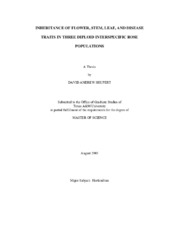| dc.description.abstract | Three F1 plants (WOB13, WOB21, and WOB26) from the hybridization of the diploid parents Rosa wichuraiana ‘Basye’s Thornless’ and ‘Old Blush’ (Rosa chinensis) were backcrossed to ‘Old Blush’ to produce three interspecific backcross populations to observe the segregation of several morphological and disease resistance traits. The qualitative traits of bloom habit, flower color, flower form, and presence of stem prickles were characterized in two locations in College Station, Texas. The quantitative traits of flower size, petal size, and number of flowers per stem were measured in College Station, Texas, and number of leaflets per leaf, powdery mildew resistance, and black spot resistance were measured in College Station and Overton, Texas. Reported modes of inheritance for flower color (pink co-dominant to white), flower form (double dominant to single), and stem prickles (prickles dominant to no prickles) agree with the results in this study. The segregation of the bloom (non-recurrent dominant to recurrent) habit trait showed a deficiency of recurrent blooming types. Sources of variation generation and/or genotype(generation) explained most of the variation for flower size, petal sizes, flowers per stem, leaflet number, powdery mildew, and black spot resistance. Different environmental conditions within the environment made replication effects significant for flowers per stem. Low incidence level of powdery mildew and different temperatures in College Station and Overton made environment effects significant. Environment x generation and environment x genotype(generation) were significant for black spot resistance. The genetic variance is about two times greater than the environment x genetic interaction which would allow selection to be done at one environment, even though black spot resistance may change some between environments. Additive gene action (no dominance) was observed for flower size, petal size, black spot resistance, and powdery mildew resistance. Gene action of partial dominance was observed for leaflet number. Gene action for flowers per stem could not be determined due to lack of variation. | en |


